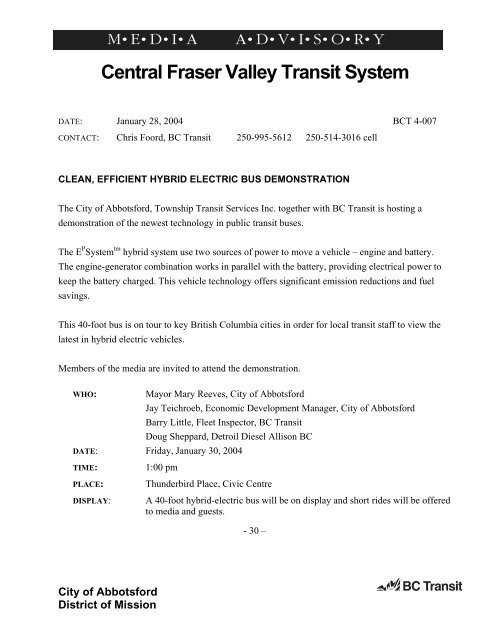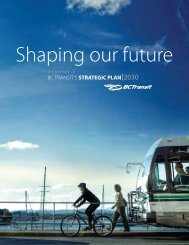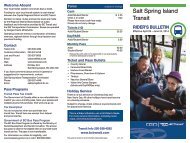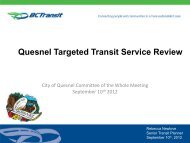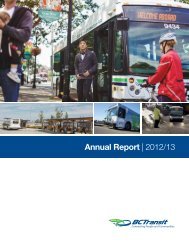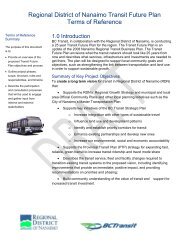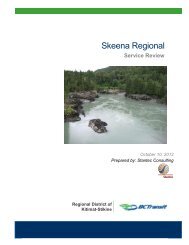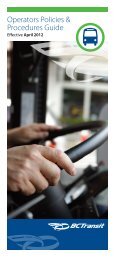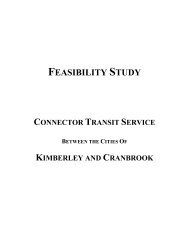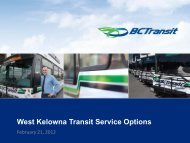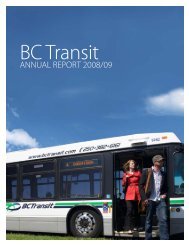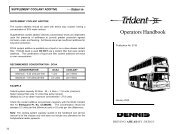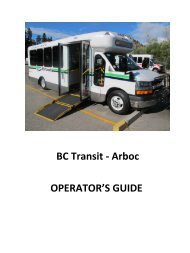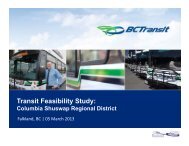clean, efficient hybrid electric bus demonstration - BC Transit
clean, efficient hybrid electric bus demonstration - BC Transit
clean, efficient hybrid electric bus demonstration - BC Transit
Create successful ePaper yourself
Turn your PDF publications into a flip-book with our unique Google optimized e-Paper software.
Central Fraser Valley <strong>Transit</strong> SystemDATE: January 28, 2004 <strong>BC</strong>T 4-007CONTACT: Chris Foord, <strong>BC</strong> <strong>Transit</strong> 250-995-5612 250-514-3016 cellCLEAN, EFFICIENT HYBRID ELECTRIC BUS DEMONSTRATIONThe City of Abbotsford, Township <strong>Transit</strong> Services Inc. together with <strong>BC</strong> <strong>Transit</strong> is hosting a<strong>demonstration</strong> of the newest technology in public transit <strong>bus</strong>es.The E P System tm <strong>hybrid</strong> system use two sources of power to move a vehicle – engine and battery.The engine-generator combination works in parallel with the battery, providing <strong>electric</strong>al power tokeep the battery charged. This vehicle technology offers significant emission reductions and fuelsavings.This 40-foot <strong>bus</strong> is on tour to key British Columbia cities in order for local transit staff to view thelatest in <strong>hybrid</strong> <strong>electric</strong> vehicles.Members of the media are invited to attend the <strong>demonstration</strong>.WHO:Mayor Mary Reeves, City of AbbotsfordJay Teichroeb, Economic Development Manager, City of AbbotsfordBarry Little, Fleet Inspector, <strong>BC</strong> <strong>Transit</strong>Doug Sheppard, Detroil Diesel Allison <strong>BC</strong>DATE: Friday, January 30, 2004TIME:PLACE:DISPLAY:1:00 pmThunderbird Place, Civic CentreA 40-foot <strong>hybrid</strong>-<strong>electric</strong> <strong>bus</strong> will be on display and short rides will be offeredto media and guests.- 30 –City of AbbotsfordDistrict of Mission
BACKGROUNDER • HYBRID-ELECTRIC BUS DEMONSTRATIONCLEAN, EFFICIENT HYBRID ELECTRIC BUS DEMONSTRATIONTransmission manufacturer Allison Electric Drives, producer of the vehicle’s E P 40 System diesel<strong>electric</strong>drive train, will visit the Central Valley <strong>Transit</strong> yard to explain the technology and offerrides on the 40-foot <strong>bus</strong>. The Central Valley is the latest stop in a <strong>demonstration</strong> tour of <strong>hybrid</strong><strong>electric</strong> technology.Hybrid technology plays a key role in producing low-emission vehicles that consume less fuel.How does it work?E P System tm <strong>hybrid</strong> system use two sources of power to move a vehicle – engine and battery. Theengine-generator combination works in parallel with the battery, providing <strong>electric</strong>al power to keepthe battery charged.The engine is operated only in its most <strong>efficient</strong> ranges. For example when accelerating from a stop,the <strong>electric</strong> transmission works to about 12 km then a blending takes place where the <strong>electric</strong> portionblends to the regular diesel use.In the acceleration process the largest fuel consumption is used. By using <strong>electric</strong>ity to generate theacceleration, diesel fuel consumption is reduced.Once the vehicle is underway, a parallel <strong>hybrid</strong> system uses the diesel engine’s mechanical power tomaintain speed. At this time the engine charges the energy storage system (battery).Fuel efficiency is achieved when the vehicle runs at its optimal speed. offering engine performanceand low exhaust emissions.A smaller internal com<strong>bus</strong>tion engine is used in the <strong>hybrid</strong>. The engine size is similar in size to amid-size pick-up truck engine.Dependent upon the type of service the <strong>bus</strong> is used in, fuel economy is projected to improve by up to60% over existing fleet averages.Reducing EmissionsHybrids offer major advances in reducing emissions such as particulates, hydrocarbons and carbonmonoxide including the ‘greenhouse’ gases believed to contribute to global warming.During independent tests, the E P System tm <strong>hybrid</strong> <strong>bus</strong>es produced 90% less carbon monoxide, 90%fewer particulates (the black smoke commonly associated with diesel com<strong>bus</strong>tion) and half thenitrogen oxide.Reducing emissions helps support Canada’s Kyoto commitment.<strong>BC</strong> <strong>Transit</strong> uses #1 diesel fuel, the <strong>clean</strong>est diesel currently available.
Less Transmission MaintenanceThe <strong>hybrid</strong> system reduces brake wear and brake-system maintenance as the need for braking isreduced. There is less components to work on in the <strong>hybrid</strong> transmission, making it easier formechanics to work on. With less parts, it generally costs less to maintain as well.Performance data on Allison-powered <strong>bus</strong>es demonstrate that 40 percent of the energy needed toaccelerate the <strong>bus</strong>es comes from the energy recovered and stored during the stopping process.The motors in the drive unit can act as engine-driven generators to keep the storage units (batteries)full. But the motors can also be driven by the weight of the vehicle itself, to create <strong>electric</strong>al energygeneration. This process, known as “regenerative braking,” also helps slow the vehicle by creating adrag on the driveline – similar to a retarder in a traditional propulsion system. When the energystorage units are charged to their pre-determined capacity, regenerative braking is not activate andthe vehicle is slowed using an exhaust or other auxiliary brake.Allison TransmissionThe <strong>hybrid</strong>s have been on trial in New York City, California’s Orange County, Seattle and Portland.Founded in 1915, Allison Transmission, a division of General Motors, has produced and sold nearlyfour million transmissions.The <strong>bus</strong>es feature a Cummins ISB engine from Cummins Inc. The engine delivers the idealcombination of power, low weight and low emissions.The <strong>bus</strong> demonstrating the E P System tm is a Gillig high floor <strong>bus</strong>. The transmission can be installedon any conventional transit vehicle when the <strong>bus</strong> is being built.<strong>BC</strong> <strong>Transit</strong>’s Role<strong>BC</strong> <strong>Transit</strong> is the provincial agency responsible for the planning, management and shared funding of69 municipal transit systems across the province. In addition, <strong>BC</strong> <strong>Transit</strong> is responsible for theacquisition of vehicles for the provincial fleet. The local government leases the vehicles from <strong>BC</strong><strong>Transit</strong>’s fleet.As <strong>bus</strong>es reach their life span they are replaced. The <strong>hybrid</strong> option means about a 40 per centpremium on the $500,000 cost of a 40-foot <strong>bus</strong> (12-metre). Increased fuel efficiency and reducedcomponent wear are projected to recoup the additional cost over the 20-year life span of the <strong>bus</strong>.Local transit systems will have the option to lease the new <strong>hybrid</strong> vehicles.<strong>BC</strong> <strong>Transit</strong> is committed to identifying and adopting new technologies to enhance environmentalquality and transit’s community benefits. The <strong>hybrid</strong>/diesel <strong>electric</strong> technology is being consideredto assist in transit’s goal.For further information, contact:Ben Mikkelsen, <strong>BC</strong> <strong>Transit</strong>Walt Dougherty, GM Corporation(250) 995-5606 ben_mikkelsen@bctransit.com (317) 915-2836 walt.dougherty@gm.comBarry Little, <strong>BC</strong> <strong>Transit</strong>(250) 995-5609 barry_little@bctransit.com


